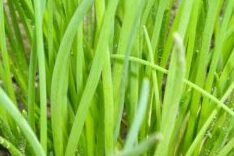Celebrate the Delicate Charm of Chives: A Garden Elegance
Chives, with their slender stalks and delicate purple blossoms, are a delightful herb that brings elegance and flavor to any garden or dish. This perennial herb, prized for its mild onion flavor and ornamental appeal, is a cherished addition to herb gardens, borders, and container plantings.
Growth and Care
Chives thrive in well-drained soil with a pH level between 6.0 and 7.0. They prefer full sun but can tolerate partial shade, making them versatile for a variety of garden settings. Chives are relatively low-maintenance, requiring regular watering to keep the soil evenly moist. They can be propagated from seeds, division, or transplants, and their compact growth habit makes them an excellent choice for edging or companion planting.
Culinary and Medicinal Uses
In the culinary world, chives are celebrated for their mild onion flavor and bright green color that adds a subtle kick to a variety of dishes. Their tender, hollow stalks are commonly used as a garnish or flavoring in salads, soups, omelets, dips, and sauces. Chives are also prized for their edible purple blossoms, which add a pop of color and delicate onion flavor to dishes. Both the leaves and flowers of chives are rich in vitamins, minerals, and antioxidants, making them a nutritious addition to any meal.
Beyond their culinary merits, chives offer several health benefits, including aiding digestion, supporting immune function, and promoting cardiovascular health. Chives contain compounds that may help reduce inflammation, lower cholesterol levels, and protect against certain types of cancer.
Weather and Seasonal Considerations
Chives are hardy perennials that thrive in cool, temperate climates and are tolerant of a wide range of temperatures. They can be grown indoors or outdoors year-round in most regions, making them an excellent choice for gardeners in both urban and rural settings. Chives are relatively drought-tolerant once established but benefit from regular watering during dry spells. To promote vigorous growth and prevent overcrowding, divide chive clumps every few years in early spring or fall.
In conclusion, chives are not just a culinary delight but also a versatile herb with a host of health benefits. By providing them with the right growing conditions and care, you can enjoy an abundance of fresh chives to enhance your dishes and elevate your well-being.

